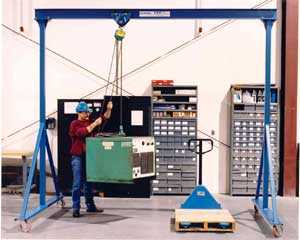With urbanization on the rise and manufacturing capacity increasing, the need for gantry cranes will rise by about six percent per year. While the COVID pandemic has reduced the rate of new construction projects, demand should recover in both public and private sector projects.
An overhead gantry crane can improve the productivity of a shop or yard that could use one. Whether this marks the first time you’ve needed a gantry crane or you’re an old hand at lifting applications, we’ll show you the basics of gantry cranes.
What Are Gantry Cranes?

A gantry crane can move around a workspace. Depending on the implementation of the gantry crane, it can rest on wheels or on a track. For the most part, gantry cranes lift loads in place, rather than moving them around.
Many users confuse gantry cranes with other types of cranes. “Portal crane” refers specifically to gantry cranes, but other names get used in the wrong circumstances often. We’ll do our best to clear this up.
A bridge crane often spans the full size of a facility, or at least a large area, and allows the user to move the load to most locations within its area. Gantry cranes tend to be much smaller. Sometimes a gantry crane will sit beneath a bridge crane.
Jib cranes, like bridge cranes, tend to be permanent fixtures. Like gantry cranes, they suit situations where operators move smaller loads. Unlike gantry cranes, however, they lack flexibility and work best when operators expect to perform the same lift often.
Monorail cranes offer a single travel path for the load. This makes them less flexible than most other types of cranes, including overhead gantry cranes and bridge cranes, but makes them perfect for repetitive identical load movements.
Types of Gantry Cranes
Depending on your needs, you can find more specialized types of gantry cranes. Depending on the size and shape of your facility, some will work better than others.
Portable Gantry Cranes
In addition to using wheels to enable movement within their space, portable gantry cranes use designs that make quick assembly and disassembly easy. Systems that allow for height adjustment make them even more flexible.
Even though they’re portable, these gantry cranes can still lift significant loads. Some portable gantry cranes can lift up to 10 tons in their standard configurations, and custom cranes can aim even higher.
Adjustable Gantry Cranes
An adjustable gantry crane can have almost every element of its size shifted. Whether you need to change the height, base width, or placement, you can safely resize it to your needs.
Semi-Gantry Crane Designs
A semi-gantry crane has one leg or set of legs in a floor track and another in a track along a wall. If you have a range of interior locations where you would need a crane but want to save floor space, a semi-gantry crane could suit your needs.
Full Gantry Crane Systems
A full gantry crane system uses a track in the floor or ground to keep movement consistent. This track will sit within the ground, rather than above it, in most cases. This allows other equipment to move around the area without disrupting the crane.
Advantages of Gantry Crane Systems
Gantry crane plans can be adapted to many facility plans. Here are some of the crucial advantages a gantry crane can offer.
Nearby Traffic
The flexible locations of gantry cranes make them good candidates for cases where you expect foot and vehicle traffic. If you consider what types of traffic you expect both under and around the crane before installation, you can almost always install a crane that won’t impede the work and may even enhance it.
Outdoor Use
As gantry cranes rest on the ground rather than being hooked into the ceiling of a building, they make great candidates for outdoor use. Railyards and steelyards often make use of gantry cranes.
Considerations For Use
While a gantry crane can be a useful tool, it also comes with a few things to consider. When you contact a company about a gantry crane, keep these things in mind.
End Truck Type
End trucks can be fixed-axle or rotating-axle. A fixed-axle truck can get dirt and dust inside its gears, while a rotating-axle truck uses an oil bath to keep them safe. Upgrading to a rotating-axle truck won’t always be necessary, but it can help with maintenance, especially on an outdoor crane.
Outdoor Care and Maintenance
Selecting the ideal gantry crane for sale becomes more difficult when you look at an outdoor application. You have to consider material and finish as well as the baseline specifications. An outdoor crane will experience wind, snow, and rain, and as a result, will need to be a little tougher than an otherwise identical indoor counterpart.
Power Delivery Solutions
Gantry cranes have varied power delivery mechanisms available depending on your needs. You can generally avoid problems like sagging cables or limited cord length during the design and installation process. If you need the power delivery to avoid the ground altogether, beams and poles can keep that space clear.
Do You Need a Gantry Crane?
While gantry cranes won’t fit every use case, they offer a flexible, robust solution for situations where cranes must be moved or operate below other cranes. If an overhead gantry crane suits your shop or yard, don’t wait to take advantage of its utility.
Looking for a crane solution in St. Louis? We can help. Contact us for everything from product inquiries to emergency service.
